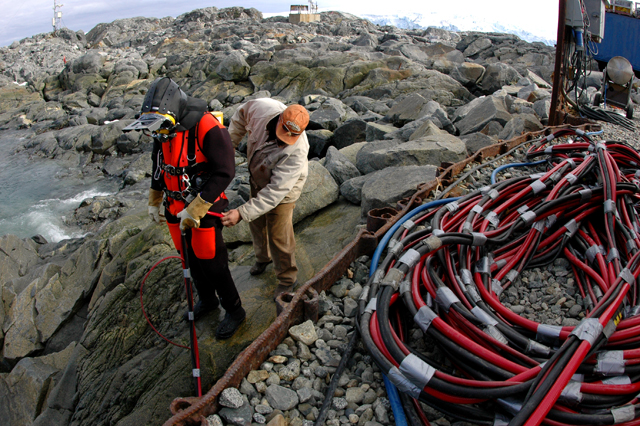
Photo Credit: Jeff Scanniello/Antarctic Photo Library |
McMurdo Station in February 2011. The National Science Foundation is requesting $18 million in fiscal year 2014 to begin addressing facility upgrades at McMurdo and Palmer stations. |
NSF FY14 budget
Polar Programs would get funds to begin McMurdo, Palmer facility upgrades
By Peter Rejcek, Antarctic Sun Editor
Posted April 26, 2013
The National Science Foundation (NSF)  released its 2014 fiscal year budget this month, requesting $7.6 billion. The request includes nearly $465 million for the Division of Polar Programs (PLR)
released its 2014 fiscal year budget this month, requesting $7.6 billion. The request includes nearly $465 million for the Division of Polar Programs (PLR)  , which includes funds to kick start a long-term plan to modernize facilities for the U.S. Antarctic Program (USAP)
, which includes funds to kick start a long-term plan to modernize facilities for the U.S. Antarctic Program (USAP)  .
.
The overall proposed budget represents an 8.4 percent increase over the 2012 fiscal year enacted budget, according to an NSF press release  . The 2014 fiscal year begins on Oct. 1.
. The 2014 fiscal year begins on Oct. 1.
NSF’s PLR, which now falls under the Directorate of Geosciences  after a reorganization last year, supports much of the research in the polar regions. About $139 million has been earmarked for research in the Arctic and Antarctic, with about 40 percent of that money going to new grants.
after a reorganization last year, supports much of the research in the polar regions. About $139 million has been earmarked for research in the Arctic and Antarctic, with about 40 percent of that money going to new grants.

Photo Credit: Peter Rejcek
Diver Steve Rupp prepares to enter the water to work on repairs to the Palmer Station pier. The NSF is requesting money in FY 2014 to address deficiencies.

Photo Credit: Ryan Wallace
The South Pole Traverse drives through blowing snow. The FY14 budget proposes funds to roboticize the tractor fleet, which carries fuel and cargo over the polar plateau.
Supporting that research isn’t cheap: Approximately 70 percent of the overall PLR budget goes toward facilities and logistics. And the USAP Facilities and Logistics budget may get an $18 million boost if Congress approves the NSF request.
The money would be used to implement recommendations made by the Blue Ribbon Panel  in a report called More and Better Science in Antarctica through Increased Logistical Effectiveness
in a report called More and Better Science in Antarctica through Increased Logistical Effectiveness  . The panel consisted of government, business and academic leaders, including former Lockheed Martin
. The panel consisted of government, business and academic leaders, including former Lockheed Martin  CEO Norm Augustine
CEO Norm Augustine  .
.
In 2010, the NSF initiated a comprehensive review of the nation’s research operations on the southernmost continent in collaboration with the White House Office of Science and Technology Policy (OSTP)  and the Office of Management and Budget (OMB)
and the Office of Management and Budget (OMB)  .
.
The process started when a committee under the National Research Council  was tasked with examining future Antarctic research priorities, which led to a report called Future Science Opportunities in Antarctica and the Southern Ocean
was tasked with examining future Antarctic research priorities, which led to a report called Future Science Opportunities in Antarctica and the Southern Ocean  . The follow-on report from the Blue Ribbon Panel was designed to provide a blueprint on how to support Antarctic research into the future.
. The follow-on report from the Blue Ribbon Panel was designed to provide a blueprint on how to support Antarctic research into the future.
The NSF issued a formal response to the Blue Ribbon Panel last month  . The federal agency noted that the panel “concluded that ushering in a new age of Antarctic science simply by expanding traditional methods of logistical support would be prohibitively costly” and therefore focused on more cost-effective and efficient ways to increase flexibility as research frontiers evolve over time.
. The federal agency noted that the panel “concluded that ushering in a new age of Antarctic science simply by expanding traditional methods of logistical support would be prohibitively costly” and therefore focused on more cost-effective and efficient ways to increase flexibility as research frontiers evolve over time.
The $18 million would be spread overall several different projects:
- $8 million to address resupply issues at Palmer Station
 by improving the condition of the pier and mitigating the underwater rock ledge that currently prevents larger vessels from docking at the station. Another $1 million would be used to purchase rigid-hull inflatable boats for the research station to improve access to areas of scientific interest and provide a more robust platform for the recovery of remote sensing systems, such as gliders and robotic underwater vehicles.
by improving the condition of the pier and mitigating the underwater rock ledge that currently prevents larger vessels from docking at the station. Another $1 million would be used to purchase rigid-hull inflatable boats for the research station to improve access to areas of scientific interest and provide a more robust platform for the recovery of remote sensing systems, such as gliders and robotic underwater vehicles.
- $2 million to “roboticize” the South Pole Traverse, a tractor train that moves fuel and cargo primarily between McMurdo and South Pole
 stations. Robotic vehicles would be capable of autonomously following a manned tractor in front of it, allowing the traverse to operate longer each day with the same number of crewmembers. Another $4 million would be used to purchase new tractors to provide a standardized tractor fleet on which to build the robotics system.
stations. Robotic vehicles would be capable of autonomously following a manned tractor in front of it, allowing the traverse to operate longer each day with the same number of crewmembers. Another $4 million would be used to purchase new tractors to provide a standardized tractor fleet on which to build the robotics system.
- $2 million to begin the first phase of a new McMurdo Station long-range plan that involves the construction of a single logistics and warehousing facility, as well as a consolidated trade shop and warehousing complex.
- $1 million to improve fire suppression engineering through a study of fire suppression requirements and existing capabilities in order to target any areas needing improvement.







